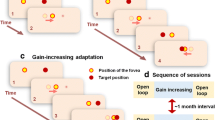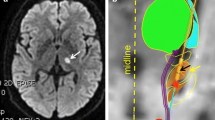Abstract
Multisensory integration is critical for resolving ambiguities in isolated sensory systems assuring accurate perception of one’s own linear motion, i.e., heading. The vestibular signal, a critical source of information for heading perception, is transformed in appropriate coordinates suitable for multisensory integration—such transformation takes place under cerebellar supervision. Deficiency in cerebellar function due to Purkinje cell loss results in inaccurate multisensory integration and impaired heading perception. Here, we predict that a classic movement disorder, the syndrome of oculopalatal tremor (OPT), also presents with inaccurate heading direction perception. The characteristic feature of oculopalatal tremor is pseudohypertrophic inferior olive that constantly sends spontaneous, hypersynchronous, abnormal, and meaningless signals to the cerebellum. Such malicious olive signal can impair heading perception. We examined vestibular heading perception in 6 individuals with OPT and 9 age-matched healthy controls (HC). We used a two-alternative forced choice task performed during passive en bloc translation. Compared with age-matched HC, OPT group had significantly higher heading direction perception threshold indicating a less sensitive vestibular system to variations in heading direction. Using computational simulations, we show that the addition of the abnormal noise into the cerebellar system results in decreased spatiotemporal tuning behavior of the cerebellar output. Such impairment in spatiotemporal tuning causes reduced ability to perceive heading direction. Hyperactivity in the inferior-olive cerebellar pathway impairs the heading direction perception. We suggest that this impairment stems from abnormal noise into the cerebellum due to hypersynchronized inferior olive.





Similar content being viewed by others
References
Bertolini G, Ramat S, Bockisch CJ, Marti S, Straumann D, Palla A. Is vestibular self-motion perception controlled by the velocity storage? Insights from patients with chronic degeneration of the vestibulo-cerebellum. PLoS One. 2012;7:e36763. https://doi.org/10.1371/journal.pone.0036763.
Shaikh AG. Motion perception without nystagmus—a novel manifestation of cerebellar stroke. J Stroke Cerebrovasc Dis. 2014;23:1148–56. https://doi.org/10.1016/j.jstrokecerebrovasdis.2013.10.005.
Shaikh AG, Palla A, Marti S, Olasagasti I, Optican LM, Zee DS, et al. Role of cerebellum in motion perception and vestibulo-ocular reflex—similarities and disparities. Cerebellum. 2013;12:97–107. https://doi.org/10.1007/s12311-012-0401-7.
Angelaki DE, Shaikh AG, Green AM, Dickman JD. Neurons compute internal models of the physical laws of motion. Nature. 2004;430:560–4. https://doi.org/10.1038/nature02754.
Gu Y, DeAngelis GC, Angelaki DE. A functional link between area MSTd and heading perception based on vestibular signals. Nat Neurosci. 2007;10:1038–47. https://doi.org/10.1038/nn1935.
Shaikh AG, Green AM, Ghasia FF, Newlands SD, Dickman JD, Angelaki DE. Sensory convergence solves a motion ambiguity problem. Curr Biol. 2005;15:1657–62. https://doi.org/10.1016/j.cub.2005.08.009.
Shaikh AG, Meng H, Angelaki DE. Multiple reference frames for motion in the primate cerebellum. J Neurosci. 2004;24:4491–7. https://doi.org/10.1523/JNEUROSCI.0109-04.2004.
Yakusheva TA, Shaikh AG, Green AM, Blazquez PM, Dickman JD, Angelaki DE. Purkinje cells in posterior cerebellar vermis encode motion in an inertial reference frame. Neuron. 2007;54:973–85. https://doi.org/10.1016/j.neuron.2007.06.003.
Ruigrok TJ, de Zeeuw CI, Voogd J. Hypertrophy of inferior olivary neurons: a degenerative, regenerative or plasticity phenomenon. Eur J Morphol. 1990;28:224–39.
Ruigrok TJ, Osse RJ, Voogd J. Organization of inferior olivary projections to the flocculus and ventral paraflocculus of the rat cerebellum. J Comp Neurol. 1992;316:129–50. https://doi.org/10.1002/cne.903160202.
Shaikh AG, Wong AL, Optican LM, Zee DS. Impaired motor learning in a disorder of the inferior olive: is the cerebellum confused? Cerebellum. 2017;16:158–67. https://doi.org/10.1007/s12311-016-0785-x.
Crane BT. Fore-aft translation aftereffects. Exp Brain Res. 2012;219:477–87. https://doi.org/10.1007/s00221-012-3105-9.
Crane BT. The influence of head and body tilt on human fore-aft translation perception. Exp Brain Res. 2014;232:3897–905. https://doi.org/10.1007/s00221-014-4060-4.
Roditi RE, Crane BT. Suprathreshold asymmetries in human motion perception. Exp Brain Res. 2012;219:369–79. https://doi.org/10.1007/s00221-012-3099-3.
Beylergil SB, Ozinga S, Walker MF, McIntyre CC, Shaikh AG. Vestibular heading perception in Parkinson’s disease. Prog Brain Res. 2019;249:307–19. https://doi.org/10.1016/bs.pbr.2019.03.034.
Bermudez Rey MC, Clark TK, Wang W, Leeder T, Bian Y, Merfeld DM. Vestibular perceptual thresholds increase above the age of 40. Front Neurol. 2016;7:162. https://doi.org/10.3389/fneur.2016.00162.
Barnett-Cowan M, Dyde RT, Fox SH, Moro E, Hutchison WD, Harris LR. Multisensory determinants of orientation perception in Parkinson’s disease. Neuroscience. 2010;167:1138–50. https://doi.org/10.1016/j.neuroscience.2010.02.065.
Bertolini G, Wicki A, Baumann CR, Straumann D, Palla A. Impaired tilt perception in Parkinson’s disease: a central vestibular integration failure. PLoS One. 2015;10:e0124253. https://doi.org/10.1371/journal.pone.0124253.
Shaikh AG, Straumann D, Palla A. Motion illusion-evidence towards human vestibulo-thalamic projections. Cerebellum. 2017;16:656–63. https://doi.org/10.1007/s12311-017-0844-y.
DeAngelis GC, Angelaki DE. Visual-vestibular integration for self-motion perception. In: Murray MM, Wallace MT, editors. The neural bases of multisensory processes. Boca Raton: CRC Press; 2012.
Yousif N, Bhatt H, Bain PG, Nandi D, Seemungal BM. The effect of pedunculopontine nucleus deep brain stimulation on postural sway and vestibular perception. Eur J Neurol. 2016;23:668–70. https://doi.org/10.1111/ene.12947.
Shaikh AG, Hong S, Liao K, Tian J, Solomon D, Zee DS, et al. Oculopalatal tremor explained by a model of inferior olivary hypertrophy and cerebellar plasticity. Brain. 2010;133:923–40. https://doi.org/10.1093/brain/awp323.
Martin TA, Keating JG, Goodkin HP, Bastian AJ, Thach WT. Throwing while looking through prisms. I. Focal olivocerebellar lesions impair adaptation. Brain. 1996;119(Pt 4):1183–98. https://doi.org/10.1093/brain/119.4.1183.
Acknowledgments
The authors thank Dr. Mark Walker and Dr. Cameron McIntyre for the help and support. The authors also thank the medical illustration team of Cleveland Functional Electrical Stimulation (FES) Center.
Funding
This work was supported by the Career Development Award from the American Academy of Neurology, George C. Cotzias Memorial Fellowship (AGS), network models in dystonia grant from the Dystonia Medical Research Foundation, and the philanthropic support to the Department of Neurology at University Hospitals—The Alan Woll Fund.
Author information
Authors and Affiliations
Corresponding author
Ethics declarations
Conflict of Interest
The authors declare that they have no conflicts of interest.
Additional information
Publisher’s Note
Springer Nature remains neutral with regard to jurisdictional claims in published maps and institutional affiliations.
Rights and permissions
About this article
Cite this article
Beylergil, S.B., Gupta, P. & Shaikh, A.G. Does Inferior-Olive Hypersynchrony Affect Vestibular Heading Perception?. Cerebellum 20, 744–750 (2021). https://doi.org/10.1007/s12311-020-01103-z
Published:
Issue Date:
DOI: https://doi.org/10.1007/s12311-020-01103-z




